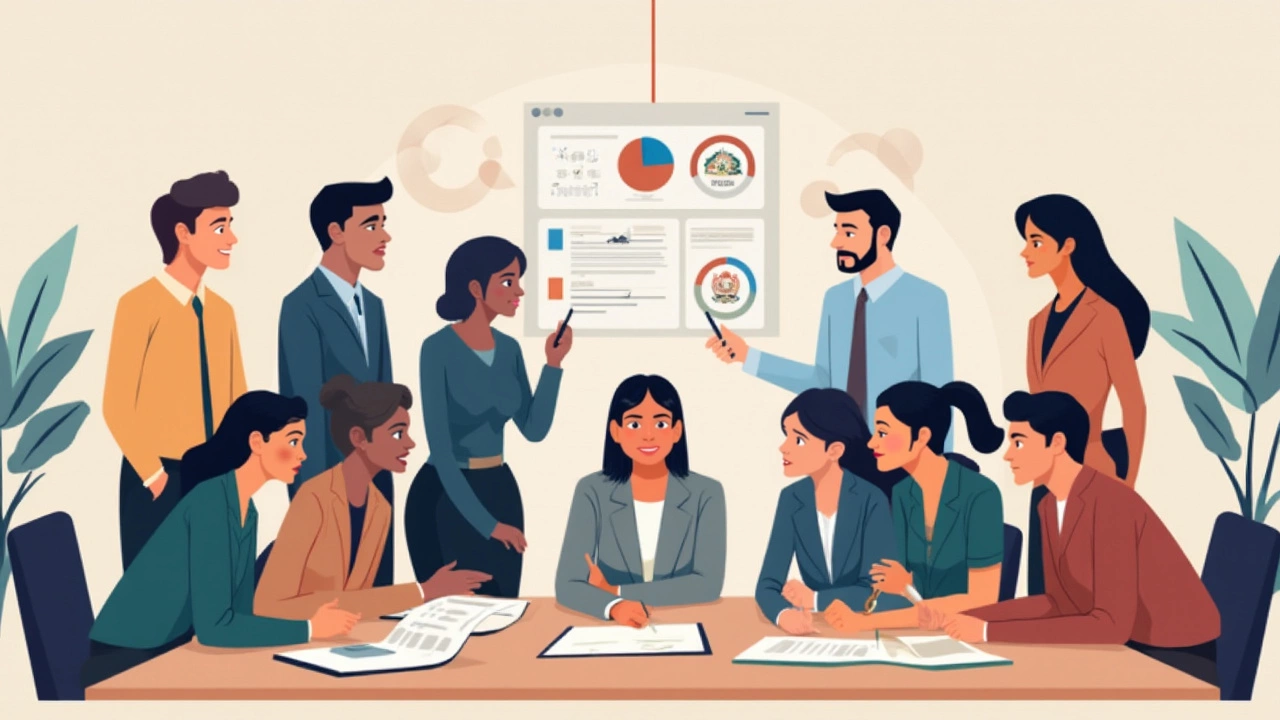Ever tried applying for a US government job and felt lost before you even understood the basics? You're not alone—and honestly, the whole process can feel like a complicated board game. But the good news? It's not as scary once you know the rules.
Most government jobs aren’t posted on random job boards. Nearly everything official is on USAJobs.gov. That’s your go-to, and yes, it does look overwhelming at first. But once you create a profile, you can set up alerts, save searches, and see exactly what they're looking for. Bonus: some listings show hundreds of annual openings, so don’t get discouraged by long listings.
Before you start clicking “apply,” know that a regular resume won’t cut it here. The federal format needs more detail—think: every duty you handled, every software you used, and numbers to prove your impact. You’ll see longer applications and a lot of government-speak, but genuinely, that’s so hiring managers can sort through massive piles fast.
- Why Work for the US Government?
- Where to Find Open Positions
- Decoding the Application Process
- Perfecting Your Federal Resume
- Acing Assessments and Interviews
- What to Expect After You Apply
Why Work for the US Government?
People aren’t just chasing US government jobs for bragging rights. It’s really about stability and benefits. Federal jobs stick around—even during a shaky economy. Most agencies don’t lay off folks easily, making this sort of work a safe bet if you don’t want to gamble your paycheck every month.
Let’s talk perks. Paid time off isn’t stingy at all here—you get federal holidays, sick leave, and generous vacation time that actually grows the longer you work. Healthcare is a big deal too. The Federal Employees Health Benefits Program lets you pick from a bunch of decent, affordable options, and those plans even extend to your family. And the Federal Employees Retirement System (FERS) means you chip into your pension, Social Security, and a 401(k)-type plan all at once, so your future self is taken care of.
If you’re looking for student loan help, some federal agencies offer up to $60,000 in loan repayment for hard-to-fill positions. There’s also tuition assistance and special scholarships just for government workers and their kids.
Let’s not forget about work-life balance. Many agencies now offer remote work or hybrid options—this ramped up after 2020 and still stands in a lot of places. Flexible schedules are real, and you’re not expected to answer emails at all hours.
Some folks like the mission-driven vibe too. You actually get to work on things that matter—a chance to make a difference at the national or local level, rather than just boosting some company’s sales numbers.
- Job security, untouched by most private sector drama
- Great health coverage and retirement plans
- Federal holidays, overtime, and solid vacation
- Loan forgiveness and tuition perks
- Options for remote and flexible work
It’s not perfect, of course—there’s plenty of red tape and the hiring process moves at government speed. But if you’re after a career that comes with stability and real benefits, this is tough to beat.
Where to Find Open Positions
If you’re new to federal job hunting, you might think you can just cruise Indeed or LinkedIn like normal. Not really. The huge majority of US government jobs aren’t even on those platforms. The top spot is USAJobs.gov—basically the official job store for federal gigs.
USAJobs is run by the Office of Personnel Management and lists over 70% of all federal openings. Every major agency has its jobs there: FBI, NASA, IRS, VA, National Park Service… you name it. Once you’ve made an account, you can filter jobs by agency, location, pay grade, and even by remote options, which are much more common since 2020.
And here’s a pro tip: some agencies post select openings on their own career pages first or at the same time. If you’re sure about a certain agency—like Homeland Security or the State Department—it’s smart to check their websites directly. The Department of State, for example, posts Foreign Service Officer positions and internships you won’t always spot on USAJobs right away.
Don’t skip out on special hiring paths either. If you’re a veteran, a recent grad (within two years), or have a disability, you can find jobs marked just for you. USAJobs has filters to show these listings—just click 'Hiring Path' when you search.
Finally, for entry-level or local jobs, check your city or state’s government job board. While it’s not "federal," getting experience at any government level looks solid on a future application up the chain.
Decoding the Application Process
The US government has its own way of doing things, and the hiring process is no exception. It’s not just about clicking 'apply' and uploading your resume. There’s a routine—sometimes way longer and a bit more tedious than private companies—but if you want that stable gig and great benefits, you’ve got to play by their rules.
First off, you’re probably going to apply through USAJobs—that’s where almost every federal vacancy is posted. Create a profile and fill out every section, even the ones that seem annoying or repetitive. The government screens a ton of resumes at once, so missing info can kick your application out before a real person looks at it.
Here’s what the process usually looks like:
- Create or update your USAJobs profile. List all work experience, education, and certifications. Save the info because you’ll use it a lot.
- Search for jobs that match your background. Use filters to sort by location, agency, salary, and job series (yes, there’s an official code for every field).
- Read each job announcement closely. Look for the 'This job is open to' section—some jobs are only for current federal employees or veterans. Don’t waste time on stuff you’re not eligible for.
- Answer the assessment questionnaire. Most jobs have an online quiz. Be honest, but don’t undersell yourself—pick the highest answer that actually fits.
- Upload your federal-format resume and all required documents. This could include transcripts, proof of veteran status, or certifications. If you miss even one, you could get cut.
The review timeline can be all over the place. For some agencies, it’s a few weeks. For others—especially places with national security jobs—it might take months. The US Office of Personnel Management says the average federal hiring process lasts about 98 days!
| Step | Typical Timeframe |
|---|---|
| Application Submission | 1 day |
| Initial Application Review | 1-3 weeks |
| Referral to Hiring Manager | 2-4 weeks |
| Interview Process | 2-4 weeks |
| Background Check & Clearance | 2-8 weeks |
| Job Offer | Anywhere from 1 week to 6 months after interview |
If you meet the basic requirements, you may get what's called "referred"—your application moves to the hiring manager. If not, you'll see "not referred" or "ineligible" in your USAJobs status. Check your status regularly; don't just wait and hope for an email.
One more thing: you can usually apply to multiple jobs at once. Seriously, don’t apply to just one and cross your fingers. The competition is stiff, so hedging your bets makes sense.

Perfecting Your Federal Resume
This isn’t like the one-pager you send to tech or retail companies. The federal government wants a blow-by-blow of your work life, and yes, they really do read it. A standard federal resume runs 3 to 5 pages. Anything shorter and you’ll probably get tossed by the system.
Here’s what matters:
- Use the US government jobs language in the job posts. Seriously, copy what you see in “Qualifications” and “Duties” if it matches you—those keywords help computers and humans flag your résumé.
- Every job entry should have exact job title, company, start and end dates (month/year), hours/week, supervisor’s name and contact, and a detailed list of what you actually did. The Office of Personnel Management checks for this stuff!
- Include numbers if possible. Instead of “helped with budgets,” try “managed an annual budget of $150,000.” Numbers show scale and impact—hiring managers love that.
- List your education like a checklist. Include your school’s full name, location, degree, major, and dates. They want the whole picture.
- No fancy fonts or colors—go plain, readable, and use headings. Bullet points make it easy to skim.
Confused about what they’re looking for? Every federal job announcement details what’s called KSAs—Knowledge, Skills, and Abilities. Hit those hard. If it says “data analysis” or “writing technical reports,” show exactly when and how you did that. This is not the time to be shy.
Fun fact: According to OPM, over 80% of federal applications are rejected just because their resume didn’t include enough detail or missed key requirements. Don’t let all your effort go down the drain for something as basic as a missing supervisor name or leaving out the hours per week.
| Section | Details Required |
|---|---|
| Work Experience | Job title, employer, dates, hours/week, supervisor, detailed duties |
| Education | Full school name, degree, dates, major |
| Certifications | Full course name, provider, completion date |
| References | Name, title, contact details |
Check your resume against the requirements in each job posting. Don’t just create one and send it to every position—they’ll notice, and you’ll wind up in the “no” pile. Taking an extra 30 minutes to tailor your resume could make or break your application.
Acing Assessments and Interviews
Straight up, getting a call for an assessment or interview means you’ve already beat out tons of people on paper. But this next step is where most folks stumble—not because they aren’t smart, but because they don’t prep like it’s a unique process (spoiler: it is).
US government jobs almost always throw in an online assessment before you even see a real person. Some are basic personality screens, others are long multiple-choice tests about your specialized knowledge. Read the job posting carefully—they actually spell out what to expect, even if it’s in fine print. If it says, “structured interview” or “occupational questionnaire,” that’s your hint to Google sample questions or even check Reddit and Glassdoor for fresh tips.
Now, the interviews. Federal interviews usually use the STAR method (Situation, Task, Action, Result) for almost every question. They want concrete examples, not just vague promises. Here’s the trick: prep stories from your past jobs using the STAR format and practice saying them out loud. You’ll be less nervous and way more convincing.
- Take notes on the agency’s mission and the exact job duties before your interview. Dropping a line about their mission shows you actually care (and usually gets a smile from the panel).
- For anything labeled as a “structured interview,” expect standard questions, strict time limits, and actual scoring sheets. Don’t ramble—be clear and on point.
- Don’t wing the technical stuff. For roles with an exam (IT, finance, law), study with official practice materials if possible. Many agencies post sample tests on their websites, like the FBI and IRS do right now.
- Always ask at least one question at the end. Good: “What does a typical day in this role look like?” Less good: “How soon can I get a raise?”
The Office of Personnel Management (OPM) literally says,
“Assessment tools vary across agencies, but they’re designed to make hiring fair and clear—if you prep and provide proof of your skills, you can stand out.”So it’s not as mysterious as it seems—a little homework puts you way ahead.
Remember, they’re not just hunting for rockstars—they’re searching for people who follow directions, communicate clearly, and really understand what working in a US government job actually means.
What to Expect After You Apply
You’ve hit “submit” on your application—now what? Here’s the deal: waiting for a response from a US government jobs application isn’t like a regular job. Most folks sit in limbo for weeks or even a couple of months before hearing anything. Don’t freak out if you don’t get an update right away. This is normal, even for the most qualified candidates.
First, you’ll probably get an automated message acknowledging your submission. That means your application landed in the system. Next, the HR team checks if you meet the minimum requirements listed in the announcement. Sometimes your application will move to a “referred” status, which means you’re being sent to the hiring manager for a closer look. If you’re “not referred,” your journey stops there for this job. Sadly, they don’t always email you if you’re out.
- Application review: Federal jobs usually get a ton of applications, so the HR team sorts out anyone who missed something obvious—like skipping the required questionnaire or not including a detailed resume.
- Eligibility check: They’ll confirm your work history, education, and any military service or veteran preference info. If a position is open to only current federal employees or veterans, that’s when they verify it.
- Referral to hiring manager: If you’ve made the cut, your name gets handed off to the actual team looking for someone. This can still mean a wait, since the hiring team can take their time to decide who makes the interview list.
If you land an interview, don’t get too stressed—the process is usually panel-style, with questions focused on scenarios, technical skills, and how you handle rules. For most jobs, they won’t move lightning-fast. Once the interview wraps up, it can take more weeks before a final pick is made.
After a job offer, you’ll go through a background check, and maybe even a security clearance if the role calls for it. These checks can take anywhere from a few weeks to several months, especially for positions in defense, Homeland Security, or intel.
One last tip: keep an eye on your USAJobs account and check your spam folder. Sometimes updates and job offers land there, and missing a reply can mean losing the opportunity completely. Staying patient and organized really is the secret weapon in surviving the government hiring marathon.


